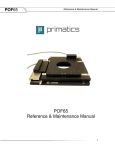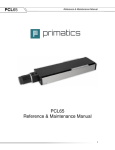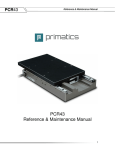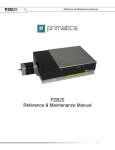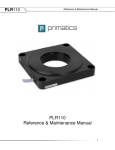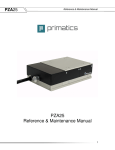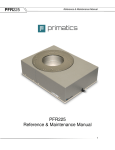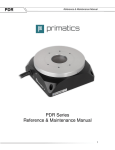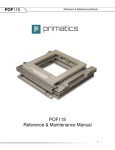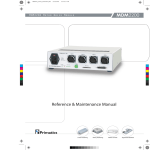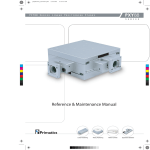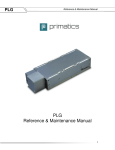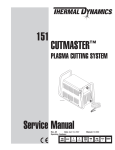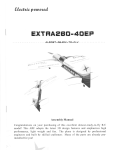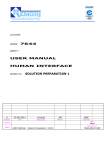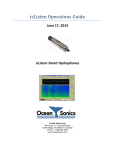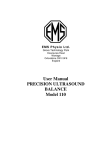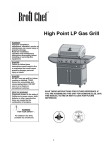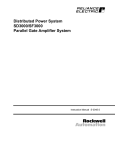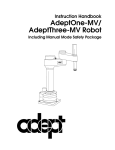Download PXL33 Reference & Maintenance Manual
Transcript
PXL33 Reference & Maintenance Manual PXL33 Reference & Maintenance Manual 1 PXL33 Reference & Maintenance Manual 32114 Mallard Ave. PO Box 409 Tangent, OR 97389-0409 U.S.A. Phone: Fax: Toll Free: Web: E-mail: [541] 791-9678 [541] 791-9410 [888] 754-3111 www.primatics.com [email protected] HHTT TTHH PXL33 Manual Revision Information Revision Date 9/25/14 12/30/14 1/20/15 Notes Original Release Corrected limit activation table (Figure 6-4) New Logo and photo Notice: The descriptions, drawings, and specifications contained herein are subject to change. Primatics is not responsible for errors or omissions herein or for incidental damages in connection with the furnishing or use of this information. This document shall not be reproduced, photocopied, or duplicated, in whole or in part, without prior written approval of Primatics Corporation. For Specifications, Dimensioned Drawings and additional information, refer to the PXL33 Datasheet available from our website at www.primatics.com. ©Copyright 2014-2015 by Primatics, Inc; All Rights Reserved. Primatics, the Primatics logo, PrimaFlex, PrimaSeal & SimpleMatch are trademarks of Primatics, Inc. 2 PXL33 Reference & Maintenance Manual PXL33 Manual Revision Information ................................................................. 2 2) Introduction – About the PXL33 .................................................................... 5 Feature Summary ........................................................................................................................ 5 3) Personal Safety ............................................................................................... 6 4) Conventions .................................................................................................... 7 4.1) Direction of Motion ............................................................................................................ 7 4.2) Units of Measure ............................................................................................................... 7 5) Installation Preparations ................................................................................ 8 5.1) Linear Motors .................................................................................................................... 8 5.2) Heat and Humidity............................................................................................................. 8 5.3) Contamination ................................................................................................................... 9 5.4) Electrical Noise ................................................................................................................. 9 6) Installing the PXL33 Positioning Stage ...................................................... 10 6.1) Tools you will need.......................................................................................................... 10 6.2) Unpacking ....................................................................................................................... 10 6.3) Mounting surface preparation ......................................................................................... 10 6.4) Mounting the Stage ......................................................................................................... 11 6.5) Electrical Connections..................................................................................................... 12 6.5.1) Hall Effect Commutation Sequence ............................................................................. 13 6.5.2) Encoder Timing Diagram ............................................................................................. 13 6.5.3) Encoder Index .............................................................................................................. 13 6.5.4) Motor Parameters ........................................................................................................ 14 6.6) Limit Sensors ................................................................................................................. 14 6.6.1) Limit Options: ............................................................................................................... 16 6.7) Recommended System Test ........................................................................................... 16 7) Preventive Maintenance ............................................................................... 17 7.1) Lubrication ....................................................................................................................... 17 8) Service ........................................................................................................... 18 8.1) Troubleshooting Help ...................................................................................................... 18 8.2) Service ............................................................................................................................ 18 3 PXL33 Reference & Maintenance Manual 1) Overview This user guide is designed to help you install and maintain your PXL33 Series linear positioning stage. Follow these steps to ensure correct stage installation and maximum stage life: Step 1 Review this entire user manual. Become familiar with all installation procedures prior to integrating your system. Step 2 Review the safety summary to develop an understanding of standard safety practices when installing and operating automated equipment. Step 3 Familiarize yourself with the conventions summary. Step 4 Review installation procedures. For best results, follow these procedures carefully. Step 5 Once you successfully complete all the installation procedures, you will be ready to install and operate your stage. Step 6 Review preventive maintenance section for proper lubrication schedule. 4 PXL33 Reference & Maintenance Manual 2) Introduction – About the PXL33 The PXL33 is a low profile linear positioning stage with cross roller bearings and a linear motor drive. The overall height is 33mm at the carriage. Two PXL33’s can be directly XY stacked for an overall height of just 66mm. It is offered with travels of 25, 60 and 110mm and encoder resolutions to 10nm. The PXL33 includes fixed forward and reverse limit sensors at the end of travel. An encoder index is located at the nominal center of travel and is used for repeatable homing of the stage. Stage performance specifications can be found www.primatics.com. The PXL33 can be used with 3 available for this purpose. rd PP PP party drives and controls. Several cable assemblies are Feature Summary • • • • • • • • • Travels of 25, 60 and 110mm Low profile and compact design. XY stack is only 66 mm tall. Direct drive linear motor drive Non-moving cables for single axes Precision linear encoder with resolution to 10nm Anti-creep bearings eliminate cage migration High bandwidth for quick settling Quiet operation Precision performance for a low price 5 PXL33 Reference & Maintenance Manual 3) Personal Safety Please review before installing your positioning stage Observe common industrial safety practices when installing and operating automated equipment. o Have power connections made by qualified personnel. o Keep fingers and other items out of any opening in the stage while it is in operation since injury or damage may result. o Provide a safe access route and adequate room for servicing. o Perform the recommended periodic maintenance described in this document. o Verify that the work envelope is free of obstructions before the positioning stage is powered. o Insure that you have the feedback wired properly to the controller before applying power to the positioning stage. Improper feedback connections can cause a motor run-away condition that has the potential to damage the stage and injure an operator. o Only trained operators of the positioning stage should be allowed near the work environment. o If so equipped, identify emergency stop circuits and actuators in the workcell. o Note the places in the workcell where pinch points occur, and provide adequate safety clearance or safety curtain. o Never operate the motor in a location that could be splashed by water, exposed to corrosive or flammable gases or is near combustible substances since this may cause an electric shock, fire or malfunction. o Never touch the motor, driver, or peripheral devices when the power is on or immediately after the power is turned off. The high temperature of these parts may cause burns. o High strength magnet fields are present. Keep ferrous metals at least 50mm away from the envelope extremes of the stage. 6 PXL33 Reference & Maintenance Manual 4) Conventions 4.1) Direction of Motion The positive direction of motion is defined as a motion away from the cable end (or motor end if applicable) of a stage. A positive direction of motion also signifies the encoder count is increasing. The reverse limit switch is activated when the carriage moves to the cable end of the stage and the forward limit switch is activated when the carriage moves to the opposite end of the stage (furthest away from the cables). Figure 4-1 illustrates this convention. Figure 4-1: Positive direction convention 4.2) Units of Measure Primatics uses the metric system for all specifications and dimensions. All linear dimensions are specified in millimeters. Accuracy, repeatability, resolution, flatness and straightness for the PXL33 are specified in microns. Load capacity is specified in kilograms and moment capacity is given in Newton-meters. All torque specifications are given in Newton-meters. Thrust specifications are given in Newtons. The following table gives some common conversions into English units: Metric Unit English Unit 1 Kilogram equals 0.0685 slug* 1 micron equals 0.0000394 inch 1 millimeter equals 0.0394 inch 1 Newton-meter equals 8.85 in-lbs 1 Newton equals 0.2248 lbs 2 *1 Kg has a weight of 2.205 lb when g = 9.8 m / s PP PP 7 PXL33 Reference & Maintenance Manual 5) Installation Preparations This section outlines installation environments. Unfavorable installation conditions may cause electric shock, fire, or breakdown. Certain breakdown situations or malfunctions in particular may lead to serious injury or other consequences. Assure that the unit is used under the following installation conditions: o o o o o o Indoors, free from being splashed by water No corrosive or inflammable gases present Well ventilated place, minimum level of dust or waste An environmental temperature range between 0-40°C, and humidity between 2080% RH (location with no condensation) Note - These values show the range in which operation can be carried out safely, but not the environmental range in which stage accuracy can be guaranteed. Stage accuracy can only be guaranteed at 20°C +/- 1°C. Location should not be affected by electrical noise. Location should be where inspection and cleaning can be performed without difficulty. 5.1) Linear Motors CAUTION: Extremely strong magnetic fields present! Damage or injury could result from ferrous materials being attracted to the magnets. Keep ferrous materials at least 100mm away from the stage. A high power Neodymium Iron Boron magnet track is mounted to the underside of the PXL33 carriage. Linear motors have large magnetic flux that can draw ferrous metals inside them from large distances, destroy magnetic media, and disrupt some electronic circuits. Materials attracted to the magnets can pinch fingers and cause injury. Keep ferrous materials at least 100mm away from the stage to minimize the risk of items being attracted to the magnet track. In addition, braking is difficult for linear motors making them inappropriate for many vertical applications. Make sure no load is attached to the linear motor stage when stage is first connected to the electronics. Linear motors can generate large accelerations and improper wiring to the control system can result in a high-speed crash. 5.2) Heat and Humidity All positioning stages are assembled and tested at 20°C. Any stage calibrations are also performed at 20°C. For optimum accuracy the ambient temperature should be maintained at 20°C. Deviations from this nominal temperature may result in degraded accuracy performance due to thermal expansion. Humidity should be less than 85% and there should be no condensation in the environment in which the stage is used. Care must be taken to limit the duty cycle of the motor to maintain highest stage performance. 8 PXL33 Reference & Maintenance Manual 5.3) Contamination The PXL33 series is intended for clean environments free from small particulates and fluids. Applications in dirty or dusty environments require the electrical, optical and mechanical components to be protected. Additional protection must also be used for stages that will be splashed with fluids. Contact your local distributor or the factory for more information on this topic. 5.4) Electrical Noise Electrical noise is the corruption of signals carried over low voltage wires. Encoder signals can be corrupted resulting in spurious encoder counts thus causing the stage to drift. Grounding, shielding, and spatial separation are all countermeasures to reduce the influences of electrical noise on performance. You can minimize the potential for electrical noise by observing the following installation precautions: o o o Physically separate low voltage conductors from those carrying high voltage. Ensure that all components are properly grounded. Ensure that all wiring is properly shielded. 9 PXL33 Reference & Maintenance Manual 6) Installing the PXL33 Positioning Stage 6.1) Tools you will need The PXL33 linear positioning stage uses M4x12mm (minimum) socket head cap screws in the base plate mounting. M4 tapped holes are available for customer use for mounting payloads to the carriage. 6.2) Unpacking Carefully remove the stage from its shipping crate and inspect it for evidence of shipping damage. Report any damage immediately to your authorized dealer. Improper handling of the stage may degrade its performance. Follow these guidelines when handling and mounting your stage. 1) Do not drop the stage onto its mounting surface. Place the stage gently on the mounting surface. Impact loads can cause high spots on mounting surfaces, misalignment of drive components and warping of the base. 2) Do not drill holes into the stage. If additional holes are necessary, contact your local distributor. 3) Lift the stage by its base structure only. . 4) Stage disassembly and alteration, unless specified otherwise, may void warranty. 5) Remove the red shipping brackets prior to use. 6.3) Mounting surface preparation The characteristics of the surface to which the positioning stage is mounted will have a large effect on system performance. An accurate and flat positioning stage will conform to the shape of the mounting surface; therefore a flat mounting surface is required. The flatness and straightness specifications can be affected under large loads. For best results in maintaining stage specifications we suggest the following guidelines: 1) Use a laboratory Grade AA granite surface plate 2) Before mounting stage, inspect for burrs or dings on the stage mounting surfaces 3) Clean all mounting surfaces with acetone In the absence of a granite surface plate, we recommend a base plate made of the same material as the base of the stage. A mounting surface constructed out of a material different from the stage base material can introduce warping in the stage in the presence of a thermal gradient. The surface flatness should match the requirements of the application; a good starting point is to have the mounting surface flat to less than 5-8µm. 10 PXL33 Reference & Maintenance Manual 6.4) Mounting the Stage The 25mm & 60mm travel stage has four mounting holes, and the 110mm travel stage has eight mounting holes. These can be accessed by moving the carriage to its forward and reverse limits by hand (motor power off) to expose the mounting holes. When tightening the mounting screws, tighten the center screws first, then radiate outwards. Figure 6-1 shows the location of the mounting holes. Figure 6-1: Mounting Hole Locations 11 PXL33 Reference & Maintenance Manual 6.5) Electrical Connections Electrical connections to the stage are made through a single circular connector described in Table 6-1. Table 6-1: PXL33 Electrical Connector Canon circular connector, size 20 shell, 28 pins, panel mount Pin Function A Motor A B Motor B C Motor C D Motor Shield E Encoder 5V – power for encoder F Encoder A+ output G Encoder A- output H Encoder B+ output J Encoder B- output K Encoder Shield L 12 - 24VDC - for limits M DCCOM N Not used P Not used R Not used S Stage Base T Hall V+ U Hall VV Encoder Ground W Encoder Index + X Encoder Index Y Forward Limit Switch Z Reverse Limit Switch A Signal Shield b Hall A c Hall B d Not used e Hall C 12 PXL33 Reference & Maintenance Manual 6.5.1) Hall Effect Commutation Sequence In the event that user amplifier and controls are being implemented, use the following motor commutation timing charts. Figure 6-1: Motor commutation chart 6.5.2) Encoder Timing Diagram The following diagrams show the signal timing for the Encoder options Figure 6-2: Timing diagram for the encoder signals 6.5.3) Encoder Index The linear encoder reference signal (index) is located at the nominal center of travel and is output in both directions of travel. Repeatability is guaranteed both directions. The reference mark output is synchronized with the incremental channels, giving it a unit of 13 PXL33 Reference & Maintenance Manual resolution pulse width. During a homing routine, the stage should travel to a limit switch transition, and then start searching for the index in the opposite direction. It is recommended that the homing procedure be performed as part of any power-up sequence to ensure the correct datum position is recorded. 6.5.4) Motor Parameters Primatics P/N 9-0044-0065 Continuous Force (N)1 9 Continuous Current (Ampsrms)1 1.5 Peak Force (N)2 30 Peak Current (Ampsrms)2 6 Force Constant (N/Ampsrms) 5 Back EMF Constant (V/m/sec) 6.1 Resistance (Ω) 3.1 Inductance (mH) 0.31 Magnetic Pitch (mm) 21 Thermal Resistance (°C/W) 1.6 Motor Constant (N√W) 2.3 1 At 25°C temperature rise 2 At 10% duty cycle and 1 second maximum 6.6) Limit Sensors Each PXL33 stage includes Forward and Reverse Limit sensors. The limit sensors are part of the linear encoder. Figure 6-3 shows the equivalent schematic for these switches. Figure 6-3: Equivalent Limit circuit schematic The forward and reverse limit sensors are factory set to give full advertised travel. That is a PXL33 with 100mm of travel will travel at least 50mm in either direction from the center of travel before activating a limit sensor. Each sensor is active from its activation point through the end of travel at the hard stop. 14 PXL33 Reference & Maintenance Manual Figure 6-4 illustrates the limit sensor factory nominal default positions. Absolute hardstop Bumper contact Forward limit trips Nominal travel Center of travel Nominal travel Reverse limit trips Bumper contact Absolute hardstop PXL33-025 +19.5mm +16.5mm +14.5mm to +13.5mm +12.5mm 0 -12.5mm -13.5mm to -14.5mm -16.5mm -19.5mm PXL33-060 +37.5mm +34mm +32mm to +31mm +30mm 0 -30mm -31mm to -32mm -34mm -37.5mm PXL33-110 +62.5mm +59mm +57mm to +56mm +55mm 0 -55mm -56mm to -57mm -59mm -62.5mm Figure 6-4: Typical Limit Sensor Transition Ranges 15 PXL33 Reference & Maintenance Manual 6.6.1) Limit Options: The Limit switches are ordered in either the Normally Closed (L1) or Normally Open (L2) configuration L1: When the carriage is in the normal operating range of travel, both limit switches are closed. When the carriage encounters a limit the switch opens. The switch will close again when the carriage is moved away from the switch. L2: When the carriage is in the normal operating range of travel, both limit switches are open. When the carriage encounters a limit the switch closes. The switch will open again when the carriage is moved away from the switch. 6.7) Recommended System Test Before attaching a load or applying power to your stage, verify the encoder and limit switches are working properly. Move the stage carriage by hand in the positive direction and verify the encoder count is increasing. Runaway conditions caused by mis-wired encoders can result in stage damage and personal injury. Move the carriage to each end of travel to ensure limit switches are working properly. When closing the position loop for the first time, set the torque limit of your controller to a low value and use conservative tuning gains. Once the control loop is working properly, payloads can be added to the stage carriage. Retuning with the payload may be required for optimal performance. 16 PXL33 Reference & Maintenance Manual 7) Preventive Maintenance Performing preventive maintenance procedures on your stage will extend its life and improve its long-term performance. The stage should be kept clean and a soft, lint-free cloth should be used wipe down the stage. Do not use compressed air to spray away dust since this may force dust into crevices. 7.1) Lubrication ALWAYS DISCONNECT MOTOR POWER BEFORE RE-LUBRICATING THE STAGE. A light instrument grade mineral oil applied to the bearings is all that is required for lubrication. After power has been disconnected from the stage, a light film of oil (1 or 2 drops max!) can be applied along the length of the crossed roller bearings when the stage is at either extreme end of travel. Cycle the stage back and forth to distribute the oil and wipe off any excess. For low duty cycle applications, it is recommended that the linear bearings are relubricated every 4-6 months or 500km of travel, whichever comes first. High duty cycle applications may require more frequent re-lubrication. Lubrication intervals depend on duty cycle, load and ambient conditions. Inspection of the bearing elements may be required to determine the proper lubrication interval. The motor and linear encoder are non-contact devices and do not need lubrication. 17 PXL33 Reference & Maintenance Manual 8) Service 8.1) Troubleshooting Help For further assistance contact the factory: M-F 8AM to 5PM Pacific Time Phone: Fax: Toll Free: Web: E-mail: [541] 791-9678 [541] 791-9410 [888] 754-3111 www.primatics.com [email protected] HHTT HHT TTHH TTHH 8.2) Service Should your device require factory service, contact the factory for a Return Materials Authorization (RMA). When inquiring about an RMA please have the following information available: o Your contact information (name, phone, email, address) o Unit Serial Number o Symptom of problem o History of troubleshooting steps already taken Figure 8-1: Unit Serial Number Location 18


















